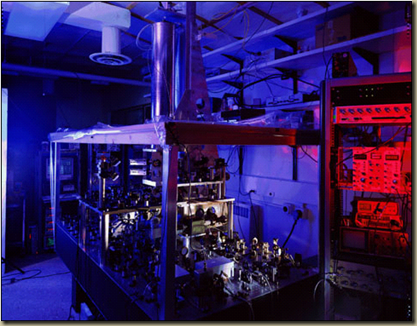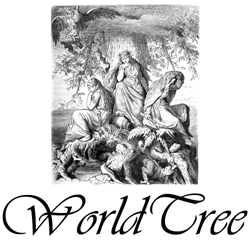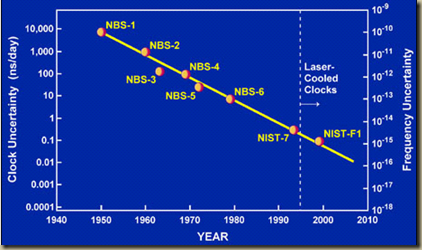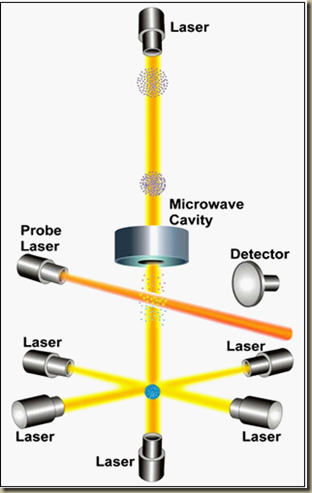NIST-F1 是美国主要的时间和频率基准,它是一个在位于科罗拉多州博尔德市NIST(The National Institute of Standards and Technology,国家标准与技术研究所)的实验室中被开发出来的铯喷泉原子钟。世界上有一群用于确立协调世界时(UTC,世界标准时间)的原子钟,NIST -F1 便是其中的一个。因为NIST-F1是世界上最准确的时钟之一,它使得协调世界时比以往更加加精确。
NIST-F1的不确定性正在持续的得到改进。在2000年的时候,其不确定性为1×10-15 ,但是到了2005年的夏天,它的不确定性达到了5×10-16 ,这也就是说,它在6000万年内的误差不会超过正负1秒!下面的图片展示了NIST-F1与之前NIST所建立的原子钟的比较,NIST-F1现在大概比NIST-7(一个在1993-1999年被用作美国主要的时间和频率基准的铯原子钟)精确10倍左右。
NIST-F1, the nation’s primary time and frequency standard, is a cesium fountain atomic clock developed at the NIST laboratories in Boulder, Colorado. NIST-F1 contributes to the international group of atomic clocks that define Coordinated Universal Time (UTC), the official world time. Because NIST-F1 is among the most accurate clocks in the world, it makes UTC more accurate than ever before.
The uncertainty of NIST-F1 is continually improving. In 2000 the uncertainty was about 1 x 10-15, but as of the summer of 2005, the uncertainty has been reduced to about 5 x 10-16, which means it would neither gain nor lose a second in more than 60 million years! The graph below shows how NIST-F1 compares to previous atomic clocks built by NIST. It is now approximately ten times more accurate than NIST-7, a cesium beam atomic clock that served as the United State’s primary time and frequency standard from 1993-1999.
技术介绍:
NIST-F1 之所以被称之为“喷泉钟”是因为它利用一群原子的如同喷泉一般的运动来确定频率和时间区间。首先,一组气态的铯原子被引入了这个原子钟的真空室。然后,六束两两相对的红外激光束汇聚在这个装置的中心。激光束轻轻地把铯原子推到一起,使之成为一个球。在形成这个球的过程中,激光束使得原子的移动速度减慢并使它们冷却到接近绝对0度的温度。
两束位于垂直方向的激光束被用来轻轻地将这个原子团向上抛(所谓的“喷泉”),然后,所有的激光束都会被关闭。这点微小的推动力仅仅只能够将原子团提升1米高并使之能够穿越一个微波腔。在重力的影响下,原子团会下落并重新穿过这个微波腔。
Technical Description:
NIST-F1 is referred to as a fountain clock because it uses a fountain-like movement of atoms to measure frequency and time interval. First, a gas of cesium atoms is introduced into the clock’s vacuum chamber. Six infrared laser beams then are directed at right angles to each other at the center of the chamber. The lasers gently push the cesium atoms together into a ball. In the process of creating this ball, the lasers slow down the movement of the atoms and cool them to temperatures near absolute zero.
Two vertical lasers are used to gently toss the ball upward (the “fountain” action), and then all of the lasers are turned off. This little push is just enough to loft the ball about a meter high through a microwave-filled cavity. Under the influence of gravity, the ball then falls back down through the microwave cavity.
来回穿越微波腔的过程持续大约1秒。在铯原子和微波信号作用的整个过程中,铯原子的原子态有可能会受到激发。当整个过程结束的时候,另一束激光就会照射在这些原子上。这些原子态被微波信号激发的原子就会发出光(一种被称为荧光【注释1】的状态【注释2】)。产生的光子,或者说就是非常小的光线,就被一个探测器所捕获。
整个过程将会在不同的微波频率之下被重复多次,终于,一个能使绝大多数铯原子被激发并且使他们发出的荧光最大的微波频率被找到了。这个频率就是铯原子的自然共振频率(9,192,631,770赫兹),这就是用来确定“秒”的频率【注释3】。
The round trip up and down through the microwave cavity lasts for about 1 second. During the trip, the atomic states of the atoms might or might not be altered as they interact with the microwave signal. When their trip is finished, another laser is pointed at the atoms. Those atoms whose atomic state were altered by the microwave signal emit light (a state known as fluorescence). The photons, or the tiny packets of light that they emit, are measured by a detector.
This process is repeated many times while the microwave signal in the cavity is tuned to different frequencies. Eventually, a microwave frequency is found that alters the states of most of the cesium atoms and maximizes their fluorescence. This frequency is the natural resonance frequency of the cesium atom (9,192,631,770 Hz), or the frequency used to define the second.
MPEG Video Demonstration of How a Cesium Fountain Works
下面是一个介绍色喷泉原子钟如何工作的视频
激光冷却和“喷泉”的设计使得NIST-F1能够以一个更长的周期来观察铯原子,从而实现了前所未有的准确度。传统的原子钟测量的对象是处于常温下并且以几百米一秒运动的原子。因为原子运动的非常迅速,可被利用与观察的时间就被限制在了区区几毫秒。NIST-F1 使用的是不同的途径。激光冷却使得原子的温度降到了仅仅比绝对0度高万分之几的水平,这就使得原子的热速度被降到了区区几厘米每秒。被激光所冷却的原子被驱动着从竖直方向上两次穿过一个微波腔,一次向上,一次向下。这样的结果就是:观测时间有大概一秒钟左右,其唯一的限制因素就是使得原子回落到地面上的重力。
也许你会想,比较长的观测时间使得调整微波的频率变得更加容易。先进的控制微波频率的技术让我们能更好地认识和控制铯原子的共振频率。当然,这也造就了属于世界上最精确的原子钟之一的NIST-F1。
The combination of laser cooling and the fountain design allows NIST-F1 to observe cesium atoms for longer periods, and thus achieve its unprecedented accuracy. Traditional cesium clocks measure room-temperature atoms moving at several hundred meters per second. Since the atoms are moving so fast, the observation time is limited to a few milliseconds. NIST-F1 uses a different approach. Laser cooling drops the temperature of the atoms to a few millionths of a degree above absolute zero, and reduces their thermal velocity to a few centimeters per second. The laser cooled atoms are launched vertically and pass twice through a microwave cavity, once on the way up and once on the way down. The result is an observation time of about one second, which is limited only by the force of gravity pulling the atoms to the ground.
As you might guess, the longer observation times make it easier to tune the microwave frequency. The improved tuning of the microwave frequency leads to a better realization and control of the resonance frequency of cesium. And of course, the improved frequency control leads to what is one of the world’s most accurate clocks.
荣誉:
NIST-F1是由来自科罗拉多州博尔德的NIST的物理实验室,时间和频率分部的Steve Jefferts 和 Dawn Meekhof 开发的。NIST-F1 的建造和实验花费了不到4年的时间。现在的NIST-F1 团队包括物理学家Steve Jefferts 和 Tom Heavner。
Credits
NIST-F1 was developed by Steve Jefferts and Dawn Meekhof of the Time and Frequency Division of NIST’s Physics Laboratory in Boulder, Colorado. It was constructed and tested in less than four years. The current NIST-F1 team includes physicists Steve Jefferts and Tom Heavner
【注释1】荧光是一种光致发光的冷发光现象。当某种常温物质经某种波长的入射光(通常是紫外线或X射线)照射,吸收光能后进入激发态,并且立即退激发并发出出射光(通常波长比入射光的的波长长,在可见光波段);而且一旦停止入射光,发光现象也随之立即消失。具有这种性质的出射光就被称之为荧光。
【注释2】光致发光(Photoluminescence,简称PL)是指物质吸收光子(或电磁波)后重新辐射出光子(或电磁波)的过程。从量子力学理论上,这一过程可以描述为物质吸收光子跃迁到较高能级的激发态后返回低能态,同时放出光子的过程。光致发光是多种形式的荧光(Fluorescence)中的一种。
【注释3】在现行国际单位制下,在1967年召开的第13届国际度量衡大会对秒的定义是:铯133原子基态的两个超精细能阶间跃迁对应辐射的9,192,631,770个周期的持续时间。

译者(Glegoo.net):这篇文章翻译自,NIST的官方网站,原文地址为:http://www.nist.gov/physlab/div847/grp50/primary-frequency-standards.cfm
原文版权及图片版权归原作者所有
注释由译者添加,来源:wikipedia
翻译东西不容易,转载本文请注明出处,ctrl c+Ctrl v党请高抬贵手



评论